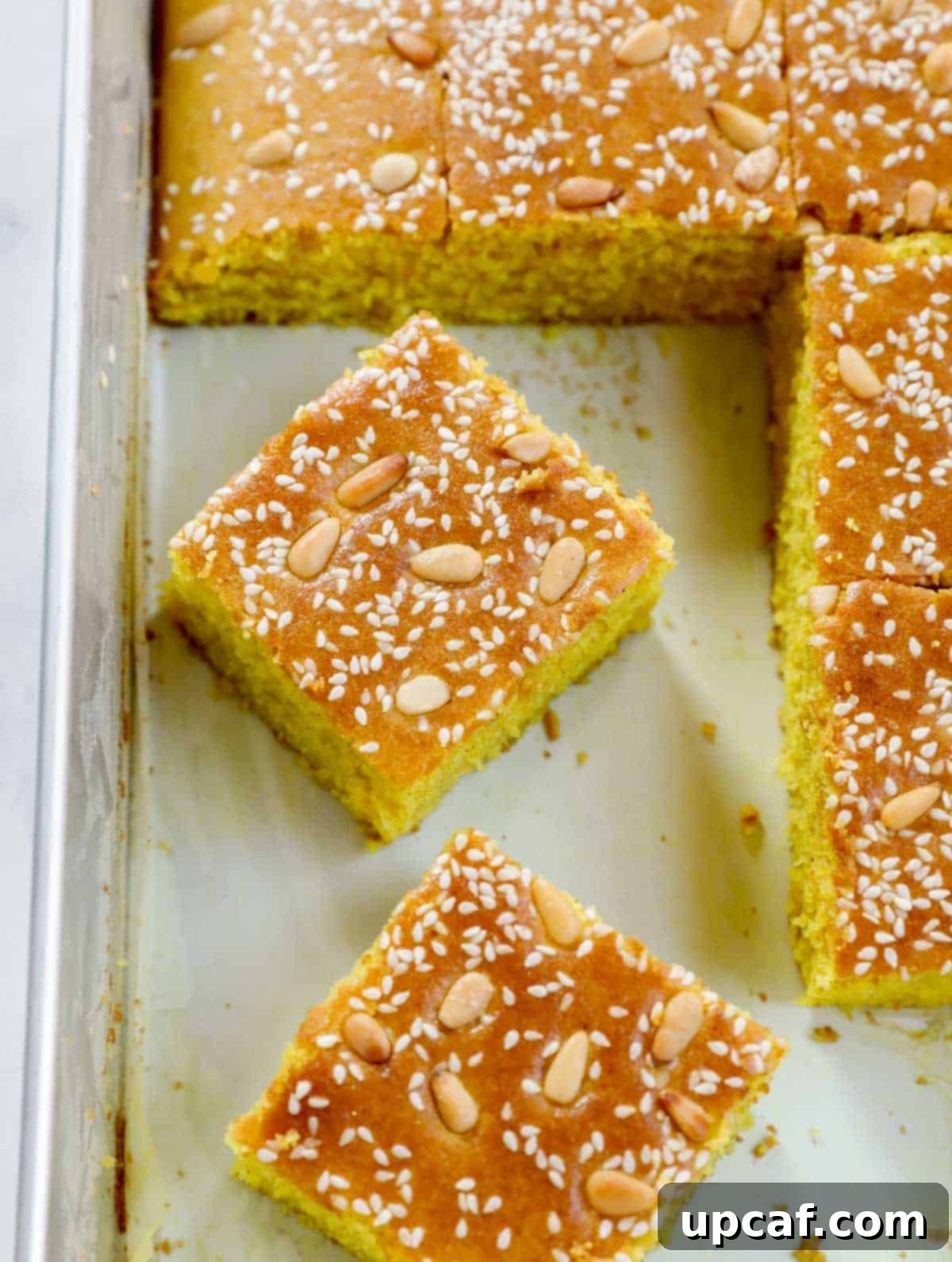Welcome to the enchanting world of Sfouf, a truly iconic Lebanese Turmeric Cake that captures the heart with its brilliant yellow hue, incredibly soft texture, and a unique blend of earthy, aromatic flavors. More than just a dessert, Sfouf is a beloved culinary tradition in Lebanon, often prepared for joyous occasions, religious holidays, and family gatherings. Crafted from humble pantry staples like fine semolina, vibrant turmeric, and sweet sugar, this cake is remarkably easy to bake, requiring only about 30 minutes in the oven. If you’re searching for an authentic, simple, and utterly delicious Lebanese dessert recipe, this comprehensive Sfouf recipe is your perfect guide to bringing a taste of the Middle East into your home.
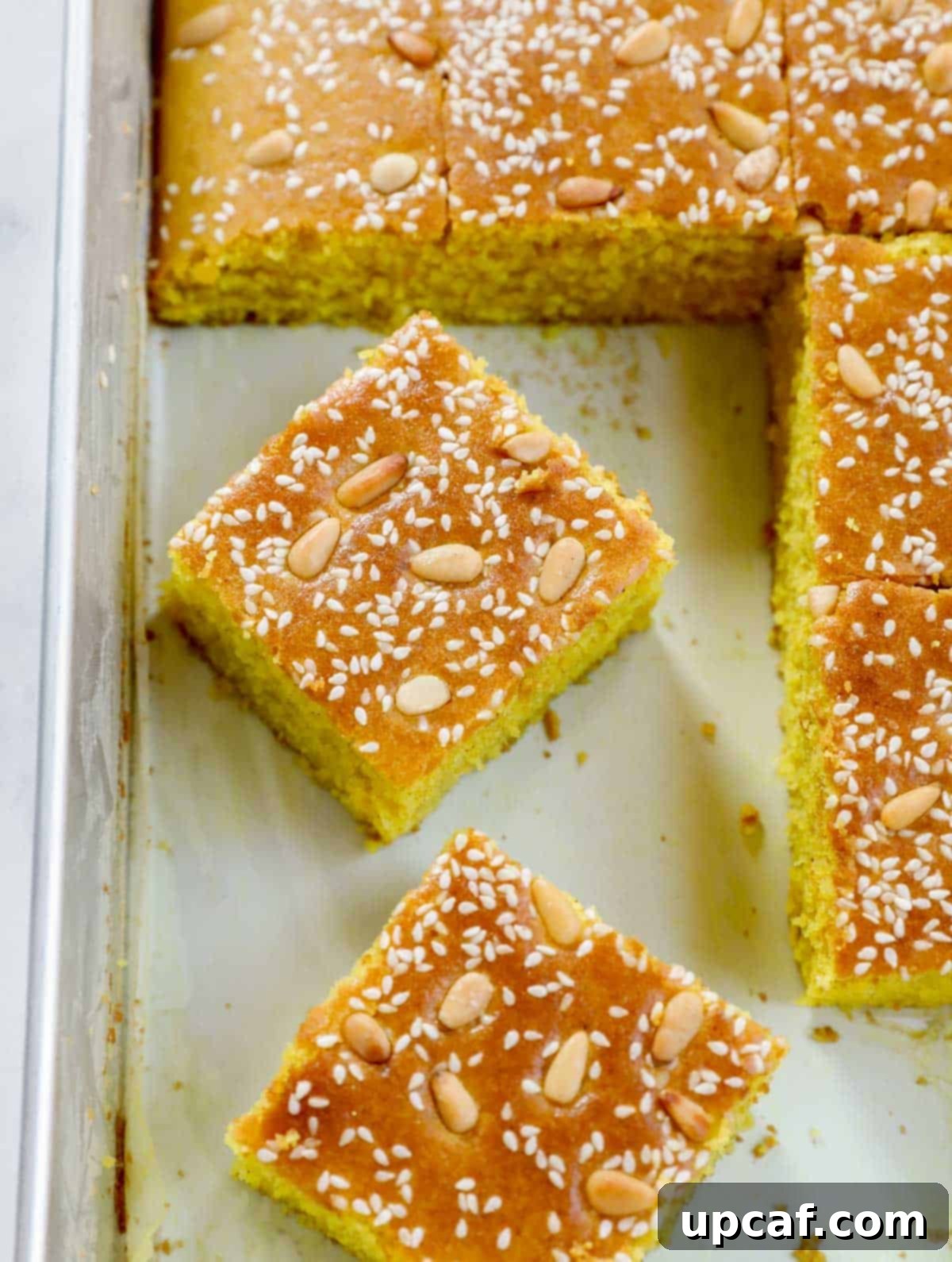
Sfouf holds a special place in Lebanese culture and in countless homes, including mine. It’s a frequent request, affectionately nicknamed “The Yellow Cake” by my children who adore its vibrant appearance and comforting taste. Its enduring popularity across Lebanon stems from its simplicity and the heartwarming feeling it evokes. Much like other cherished Middle Eastern sweets such as Namoura, Sfouf is a testament to the rich culinary heritage of the region. While you’re here, be sure to explore my Lebanese Namoura Recipe for another delightful experience.
This traditional Lebanese cake is not only a feast for the eyes but also a journey for the senses. Its inviting aroma fills the kitchen as it bakes, promising a tender, moist crumb infused with subtle spice. The recipe has been passed down through generations, making it a staple during celebrations like Easter, Christmas, and even during fasting periods when dairy and eggs are avoided (though this recipe includes milk, it can be adapted). Its straightforward preparation makes it accessible even for novice bakers, ensuring a delightful outcome every time.
Why You’ll Adore This Authentic Lebanese Turmeric Cake
There are countless reasons why Sfouf has remained a beloved classic for centuries. Here’s why this recipe will quickly become a favorite in your kitchen:
- Exquisite & Unique Flavor Profile: Sfouf stands apart with its distinctive taste, a harmonious blend where the warm, slightly peppery notes of turmeric meet the sweet, aromatic embrace of anise. The subtle nutty undertone from tahini (used for greasing the pan) further elevates this cake, creating an unforgettable earthy sweetness that is truly unique to Middle Eastern baking.
- Effortlessly Simple to Prepare: This recipe champions ease. With common pantry ingredients and straightforward steps, even beginners can achieve a perfectly baked, delicious cake. It’s a one-bowl wonder that requires minimal fuss and no complicated techniques, making it ideal for a quick dessert or spontaneous baking.
- Perfect for Any Gathering: Sfouf is a crowd-pleaser that shines on any table. Its beautiful golden color and enticing aroma make it a wonderful centerpiece for family gatherings, holiday celebrations, or casual tea parties. It pairs exceptionally well with a hot cup of tea or a rich, aromatic Arabic coffee, inviting conversation and camaraderie.
- Impressive Shelf Life & Make-Ahead Friendly: One of the many conveniences of Sfouf is its ability to remain moist and flavorful for several days at room temperature. This makes it an excellent choice for meal prepping desserts or for those busy weeks when you need a ready-to-enjoy treat. It’s also freezer-friendly, allowing you to savor its goodness whenever a craving strikes.
Essential Ingredients for Crafting the Perfect Sfouf
The magic of Sfouf lies in its simple yet powerful combination of ingredients. Each component plays a vital role in achieving its characteristic flavor, texture, and color. Here’s a closer look at what you’ll need:

- Fine Semolina and All-Purpose Flour: The foundation of our cake. Fine semolina, derived from durum wheat, is crucial for Sfouf’s signature coarse yet tender crumb and moist texture. It provides a delightful chewiness that distinguishes this cake. All-purpose flour is added to offer a balanced structure and ensure the cake holds together beautifully.
- Granulated Sugar: Provides the essential sweetness that balances the earthy spices. The quantity can be easily adjusted to suit your personal preference, allowing for a less sweet cake if desired without compromising flavor.
- Turmeric Powder: This golden spice is non-negotiable for Sfouf. It imparts the cake’s iconic vibrant yellow color and contributes a subtle, warm, earthy flavor that is mild and distinct, not overpowering. Beyond its culinary uses, turmeric is also celebrated for its potential health benefits, adding an extra dimension to this delightful dessert.
- Anise Powder: A key aromatic ingredient that infuses the cake with a unique, sweet, licorice-like aroma and flavor. Anise distinguishes Sfouf from other turmeric cakes, adding depth and complexity. While some recipes might omit it, I wholeheartedly recommend including it for that authentic Lebanese taste. You can use ground aniseed or finely crush whole anise seeds.
- Baking Powder: The leavening agent that ensures Sfouf achieves its light, fluffy, and tender texture. It reacts during baking to create air bubbles, giving the cake its delightful lift and airy crumb.
- Pine Nuts or Raw Sesame Seeds: These are traditionally used as toppings, adding visual appeal and a pleasant, nutty crunch. Pine nuts offer a buttery flavor, while sesame seeds provide a more pronounced nuttiness and a beautiful texture contrast. You can choose one or use both; my children, for example, prefer the sesame seed topping. Consider lightly toasting them for enhanced flavor before sprinkling.
- Oil (Avocado Oil or Extra Light Tasting Olive Oil): Essential for moisture and richness without imparting a strong flavor. Avocado oil is neutral and healthy, while extra light tasting olive oil offers a very subtle fruitiness that complements the cake beautifully. Vegetable oil is also a perfectly acceptable substitute, ensuring the cake remains wonderfully moist.
- Warm Whole Milk: Acts as the liquid component, binding the ingredients together and contributing to the cake’s moistness. Using warm milk helps to dissolve the sugar more effectively and can aid in activating the baking powder for a better rise. For those seeking a dairy-free or vegan option, unsweetened almond milk or soy milk can be excellent substitutes, keeping the milk warm for optimal results.
- Tahini: This ground sesame paste is a hidden hero in Sfouf. Not only does it provide a distinct, nutty flavor that deepens the cake’s profile, but it’s primarily used to grease the baking pan. Tahini creates a natural non-stick layer and forms a slightly caramelized, subtly nutty crust on the bottom of the cake, adding another layer of texture and taste.
Full measurements and precise quantities for each ingredient are conveniently listed in the detailed recipe card located at the conclusion of this blog post.
Step-by-Step Guide: Crafting Your Own Lebanese Turmeric Cake (Sfouf)
Making Sfouf is a delightful and straightforward process. Follow these simple steps to create a beautiful and delicious cake that will impress everyone.
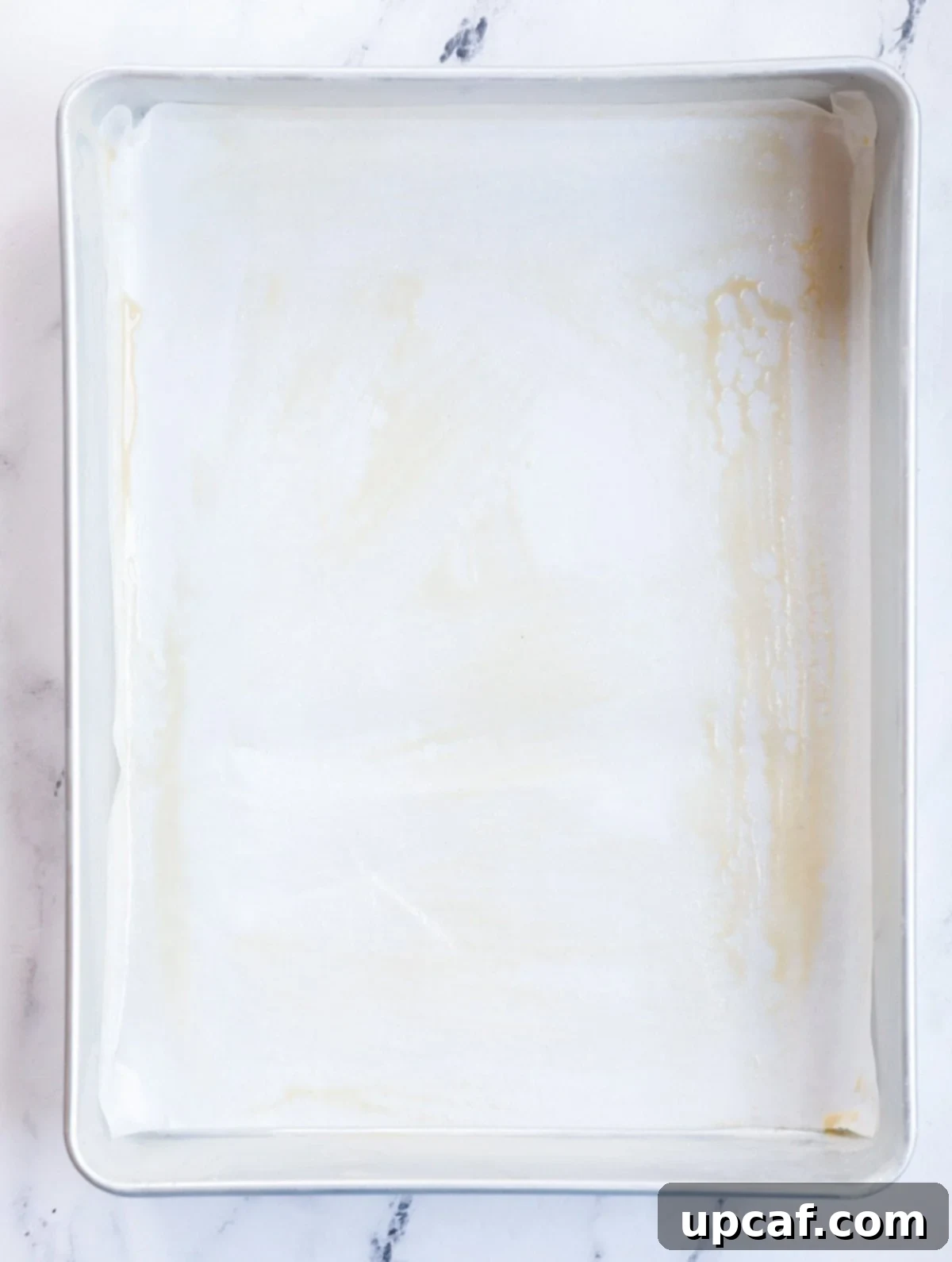
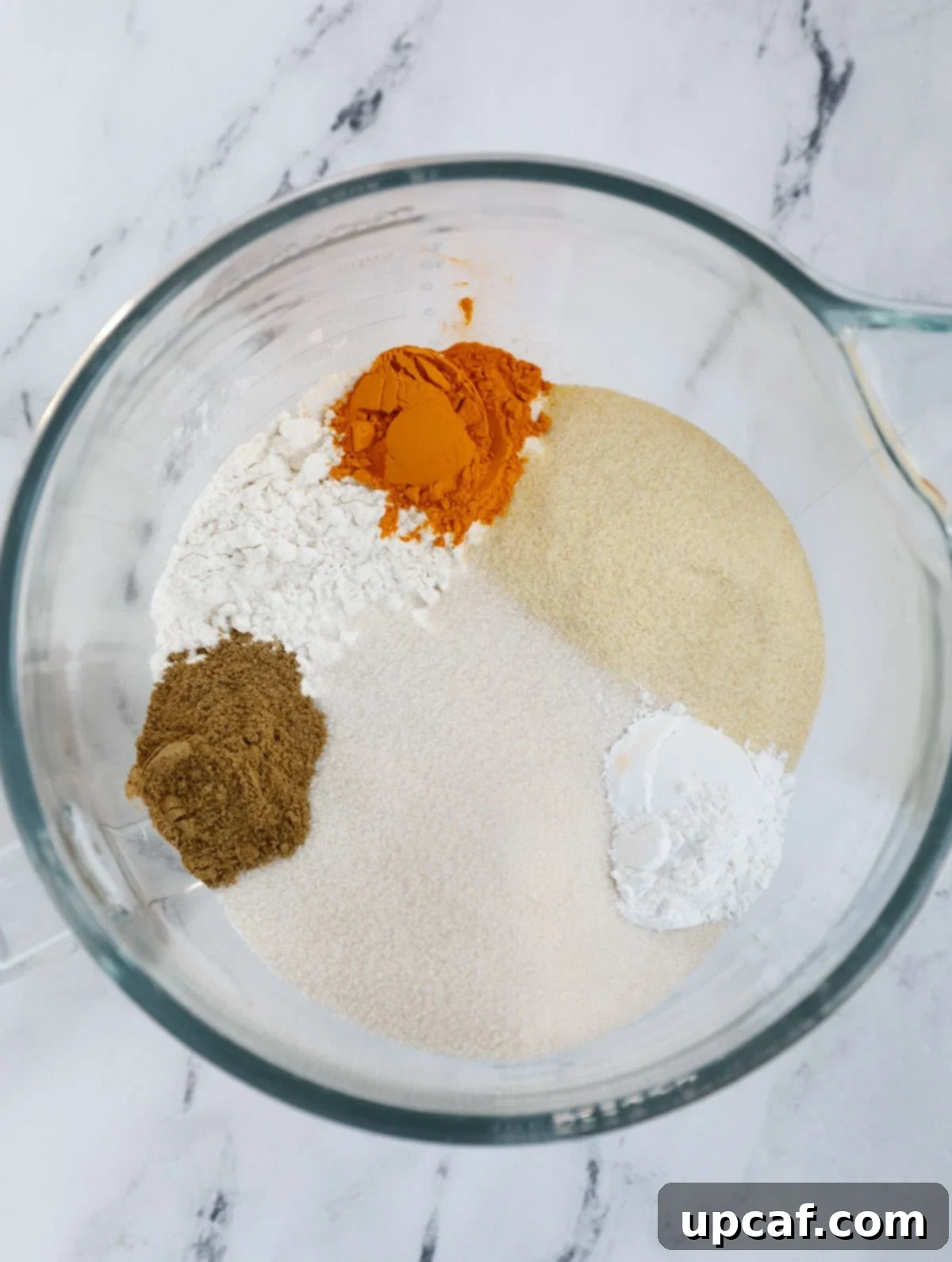

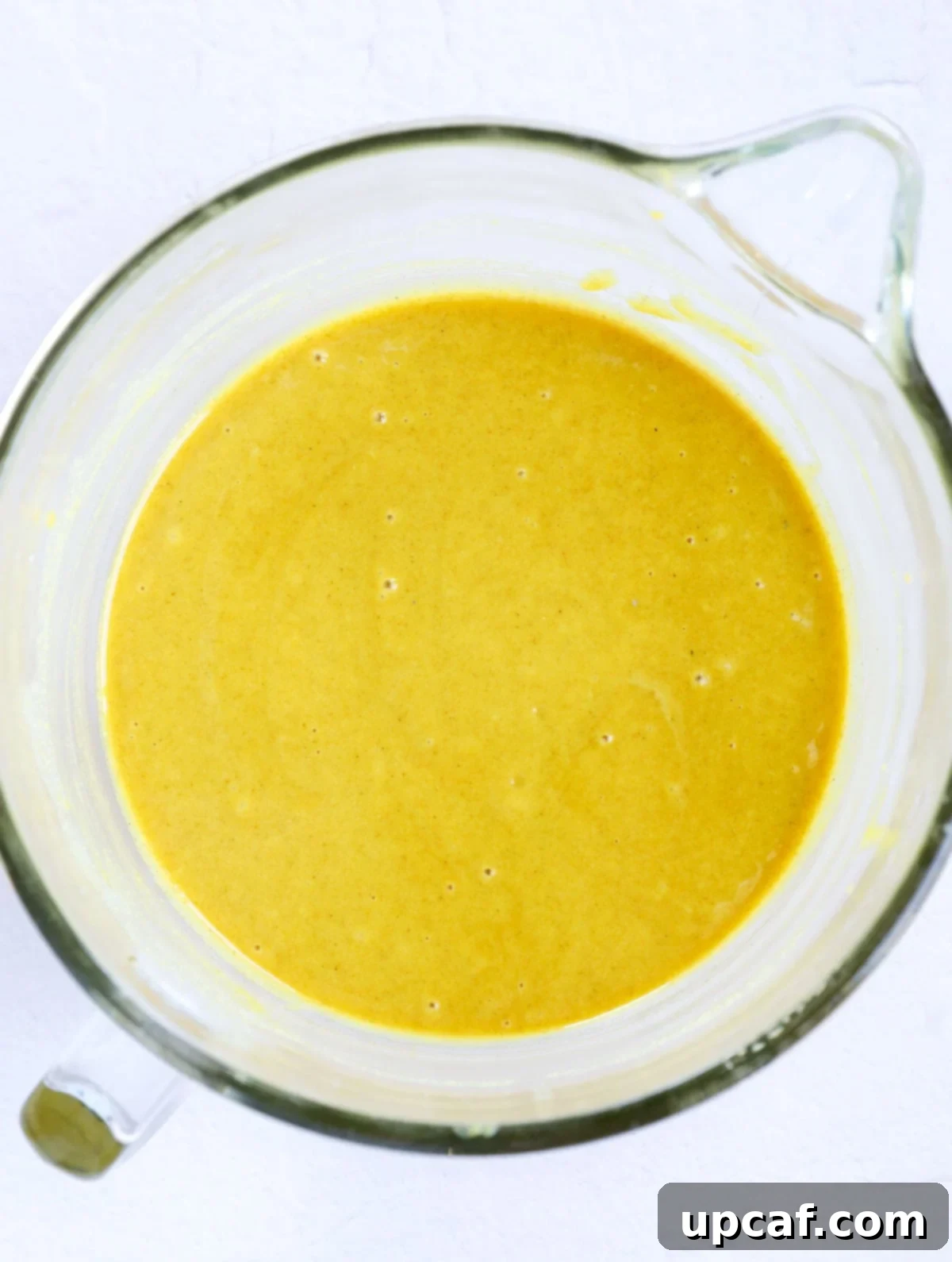

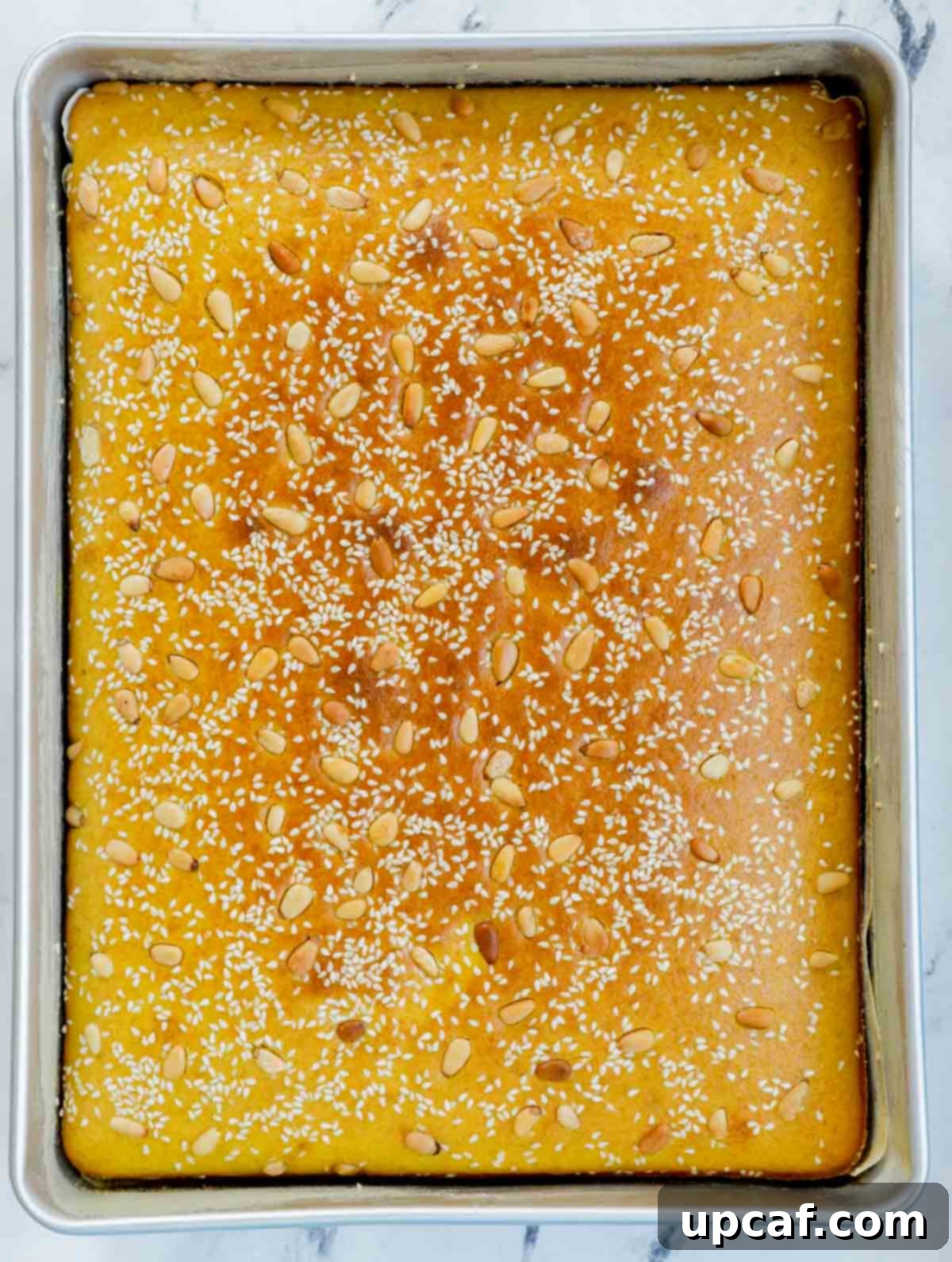
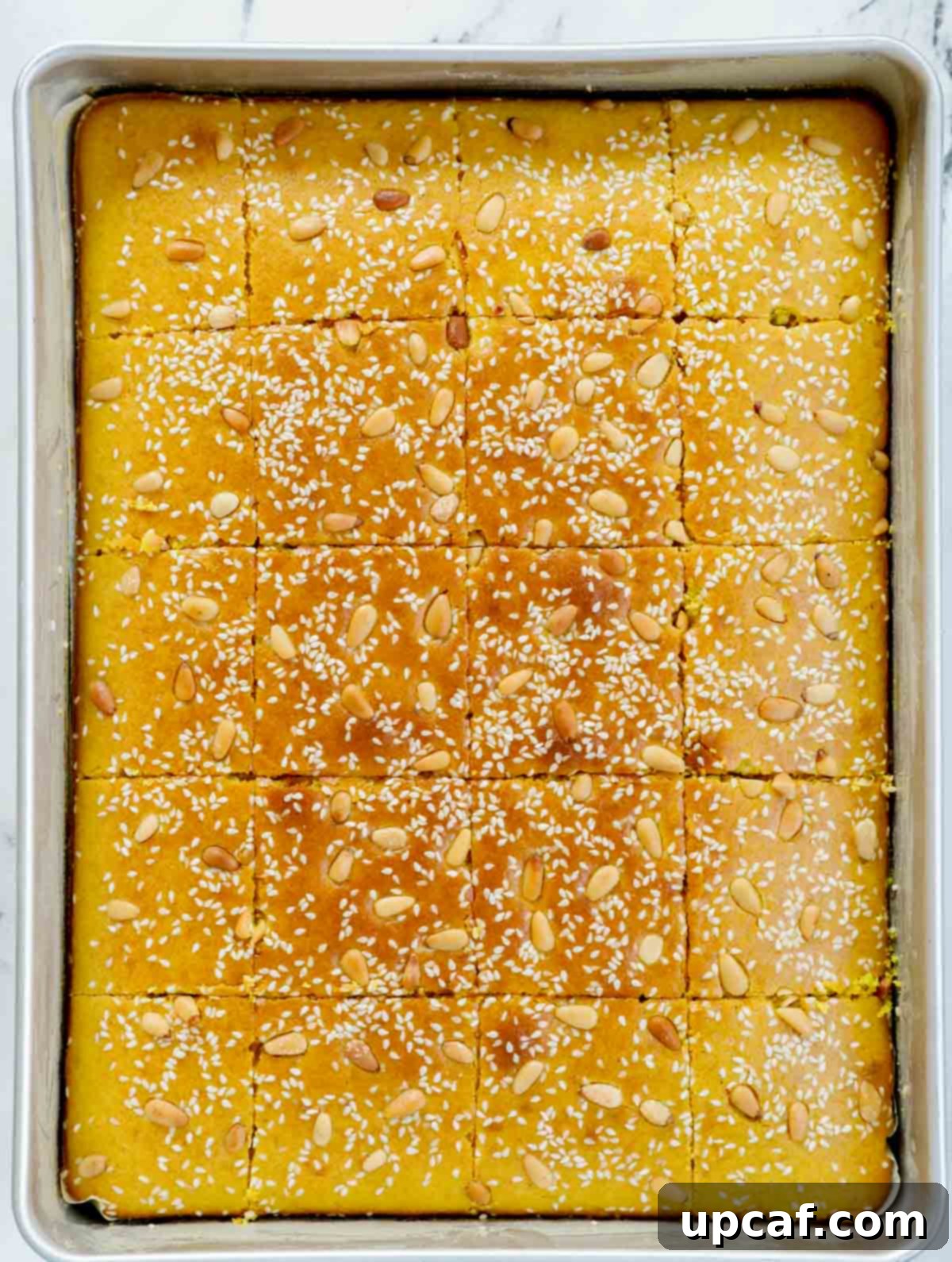
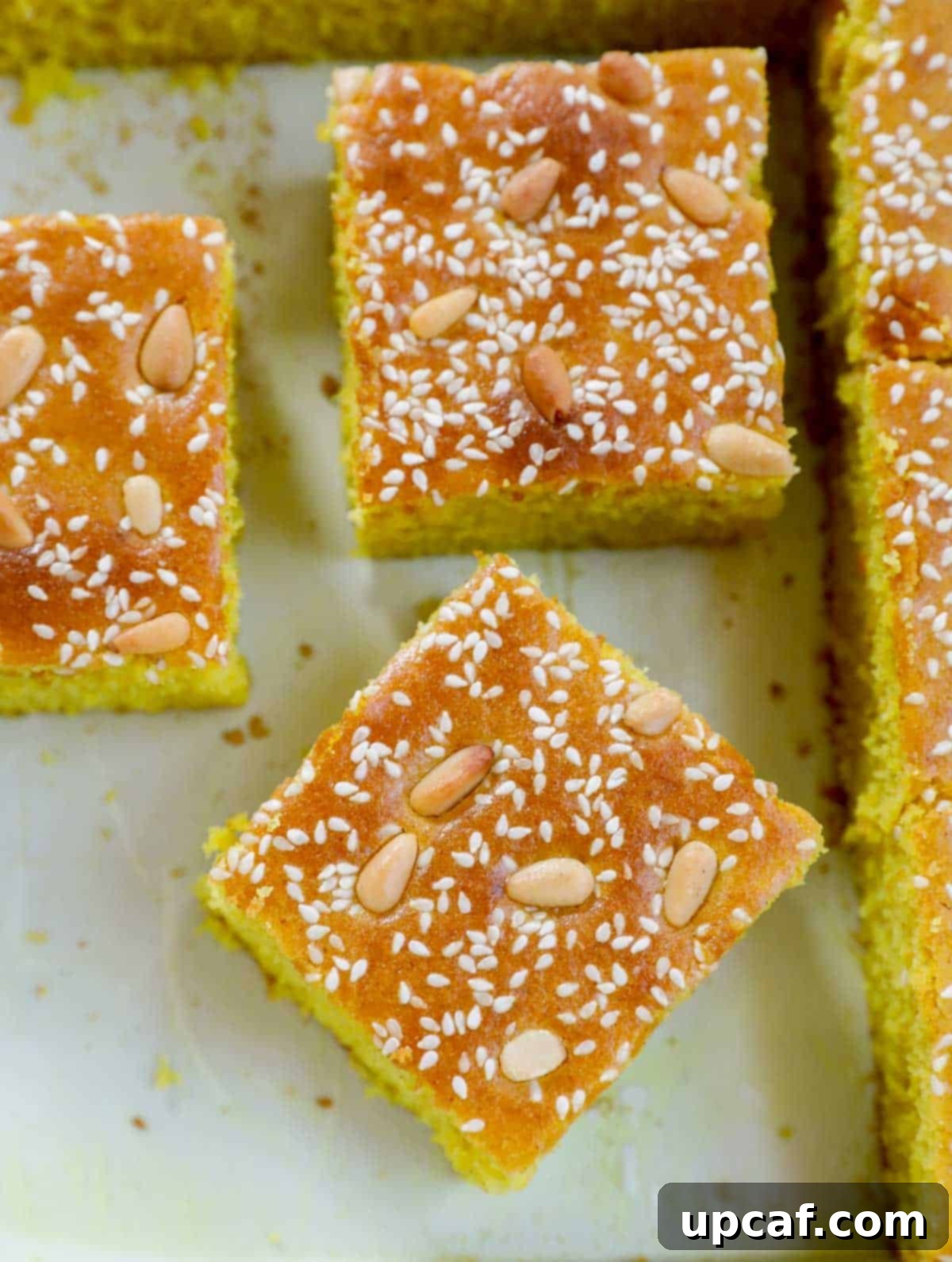
Expert Recipe Tips for Flawless Sfouf
Achieving perfect Sfouf every time is easy with a few key considerations:
- Avoid Overmixing the Batter: Once the wet ingredients are added, mix just until everything is combined and a smooth batter forms. Overmixing can overdevelop the gluten in the flour, resulting in a tough and dense cake rather than the desired light and tender texture.
- Always Grease Your Pan with Tahini: This isn’t just for preventing sticking; it’s an essential flavor component. The tahini creates a delightful, slightly nutty, and caramelized crust on the bottom of the cake, adding a layer of complexity that is characteristic of authentic Sfouf.
- Achieving the Ideal Golden Color: The turmeric gives Sfouf its signature yellow, but for a beautiful golden-brown top, monitor your cake closely towards the end of baking. If it’s cooked through but needs more color, a quick broil on low for 1-2 minutes can work wonders. Be incredibly vigilant, as broiler temperatures can vary, and cake can burn quickly.
- Allow the Cake to Cool Completely: Patience is a virtue when it comes to Sfouf. The cake firms up significantly as it cools, which is crucial for achieving clean, neat slices. Cutting it warm will likely result in a crumbly mess. Let it rest for at least an hour, or until fully cooled, before slicing and serving.
- Ensure Ingredients are at Room Temperature (or Warm): For the best consistency and even mixing, ensure your dry ingredients are well whisked and your milk is warm as specified. This helps everything combine smoothly without lumps and promotes proper activation of the baking powder.
Storage Recommendations for Keeping Sfouf Fresh
One of the beauties of Sfouf is its excellent keeping qualities, allowing you to enjoy this delightful cake over several days.
Storing Sfouf at Room Temperature: To maintain its freshness and delightful moisture, store your baked and cooled Sfouf in an airtight container. Keep it in a cool, dry place at room temperature, away from direct sunlight or heat. When stored correctly, Sfouf will remain moist and delicious for up to 1 week, making it a perfect make-ahead dessert.
Freezing Sfouf for Longer Enjoyment: If you’ve baked a large batch or simply want to savor Sfouf for a longer period, it freezes exceptionally well. Wrap individual slices tightly in plastic wrap, then place them in an airtight freezer-safe container or a heavy-duty freezer bag. Sfouf can be stored in the freezer for up to 2 months. To enjoy, simply thaw the desired portions at room temperature. While it’s truly easy to make and best enjoyed fresh, freezing offers a convenient option to have this wonderful treat on hand.
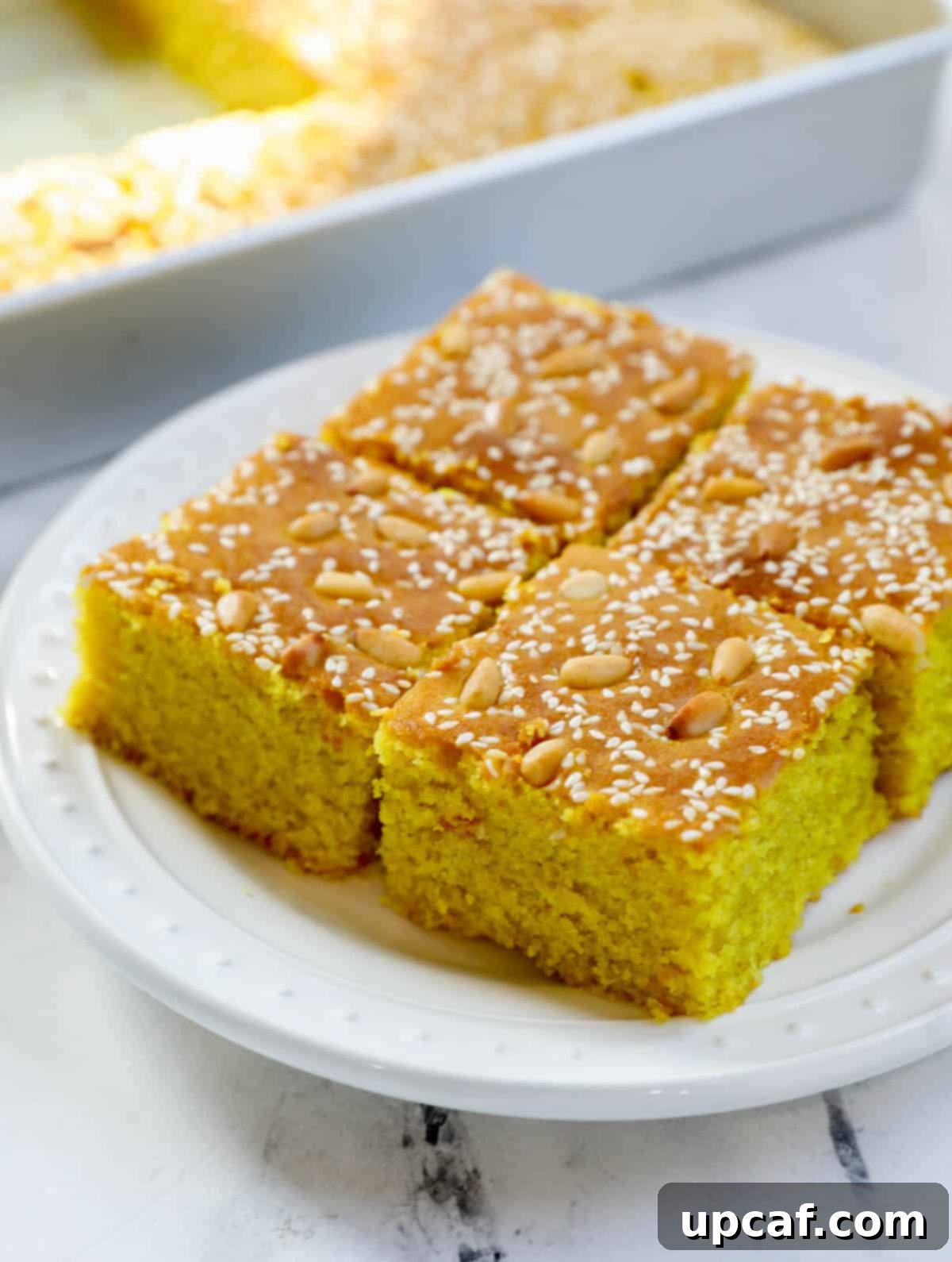
Commonly Asked Questions About Sfouf
Here are answers to some of the most frequently asked questions about making and enjoying Lebanese Sfouf:
Absolutely, turmeric is indispensable for Sfouf. It’s the ingredient that gives the cake its characteristic vibrant yellow color, which is a hallmark of this traditional Lebanese dessert. Beyond color, it imparts a subtle, earthy, and warm flavor that is integral to Sfouf’s unique taste profile.
While some variations of Sfouf exist without it, I wholeheartedly and strongly recommend including ground anise powder. It provides a distinctive sweet and aromatic, licorice-like flavor that elevates the cake and truly captures the essence of traditional Sfouf. It adds an incredible depth that would be missed otherwise.
Sfouf pairs beautifully with warm beverages. Consider serving it with:
Lebanese Tea (Chai or Mint Tea): The mild sweetness and soothing warmth of Lebanese tea perfectly complement the cake’s flavors, creating a comforting experience.
Arabic Coffee (Turkish Coffee): The rich, strong, and slightly bitter notes of Arabic coffee provide an excellent contrast, enhancing the subtle nutty and earthy flavors of the Sfouf.
Yes, this recipe can easily be adapted for vegan and dairy-free diets. Simply substitute the whole milk with an equal amount of unsweetened plant-based milk, such as almond milk or soy milk. Ensure the plant-based milk is warmed before adding to the batter for best results. The tahini used for greasing the pan is already plant-based.
While semolina is key to Sfouf’s unique texture, you can experiment with replacing a portion of it with all-purpose flour, but it will alter the traditional crumb. For the most authentic result, it’s best to use fine semolina as specified, as it provides that distinct coarse yet tender mouthfeel that all-purpose flour alone cannot replicate.
A dense or dry Sfouf is usually due to one of two reasons: overmixing the batter or overbaking the cake. Remember to mix only until the ingredients are just combined to avoid developing too much gluten. Also, closely monitor the baking time and rely on the toothpick test; remove the cake from the oven as soon as the toothpick comes out clean.
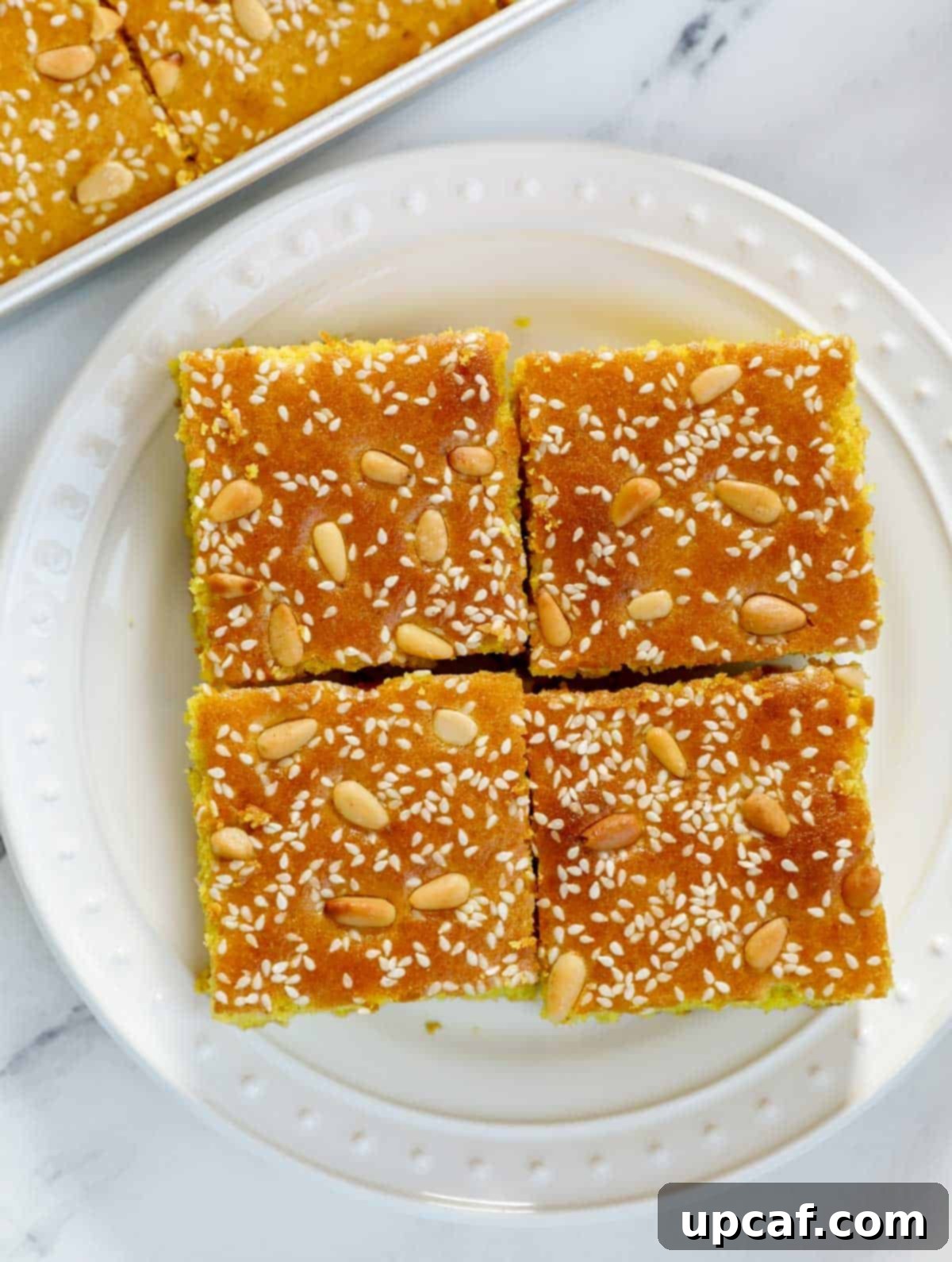
Explore More Delicious Lebanese Recipes
If you’ve fallen in love with the flavors of Lebanon, you’ll be delighted by these other traditional treats:
- Atayef Recipe With Ashta
- Homemade Baklava Recipe
- How to Make Simple Syrup (Ater)
- Lebanese Shaabiyat Recipe
- Lebanese Nights (Layali Lubnan)
This authentic Lebanese Sfouf recipe offers more than just a simple cake; it’s a delightful journey into the heart of Middle Eastern baking. With its distinctive golden color, soft crumb, and unique blend of earthy and aromatic flavors, Sfouf is truly a standout dessert that celebrates tradition and taste. Whether you choose to enjoy it with a steaming cup of coffee, a soothing glass of tea, or simply as a comforting snack, its inviting presence and delightful texture are sure to leave a lasting impression. We encourage you to try this timeless treat and experience the warmth and flavor that have made it a cherished favorite for generations.
If you’ve had the pleasure of trying this recipe or any other delightful creations from my collection, please take a moment to leave a star rating and share your thoughts in the comment section below. Your feedback is greatly appreciated! For all my latest social posts, recipes, and culinary inspirations, be sure to follow Cookin’ With Mima on Facebook |Instagram |Pinterest. Happy baking!

Pin
Sfouf (Lebanese Turmeric Cake)
Equipment
- 1 15 x 10 inch tray
Ingredients
- 2 cups flour
- 1 cup fine semolina flour, (durum wheat semolina)
- 2 cups sugar, 1.5 for less sweet cake
- 2 cups warm milk, whole milk
- 1 tbsp. turmeric powder
- 1½ tbsp. baking powder
- 1 tbsp. ground aniseed powder, yensoon
- 1 cup extra light tasting olive oil, Swap with avocado/ or vegetable oil
- ¼ cup raw pine nuts, for topping
- 2 tbsps. tahini paste, for greasing the tray
Instructions
- Preheat the Oven. Set it to 350°F (175°C).
- Grease a 15 x 10 inch non-stick baking pan lined with parchment paper with tahini paste.
- Mix Dry Ingredient. In a large bowl, whisk together semolina, flour, turmeric, anise powder, baking powder, and sugar.
- Add Wet Ingredients. Stir in the oil first, once well incorporated, continue adding the warm milk and mix until well combined. Takes about 1 minute.
- Pour & Top: Pour the batter into the prepared pan and smooth the surface. Also tap it for any air bubbles to come out. Sprinkle with pine nuts or sesame seeds.
- Bake the cake. Bake for 30 minutes until golden and a toothpick inserted comes out clean. Don’t over bake. If the cake is not brown enough, slightly broil it for 1 minute to achieve desired color. Keep a very close eye on it.
- Cool & Serve: Let it cool before slicing into 20 square portions.
Video
Notes
- Don’t Overmix: Stir just until combined to avoid a dense cake.
- Grease with Tahini: It enhances the flavor and prevents sticking.
- Achieving desired color: If your cake is cooked on the inside and still not as brown as you would like on the outside, broil the top of the cake on low for 1-2 minutes you achieve your desired color. Make sure you keep a close eye on it if you do so.
- Let It Cool Completely: Sfouf firms up as it cools, making slicing easier.
- Store Sfouf in an air tight container and leave in a cool room temperature for up to 1 week.
Nutrition
Like this recipe? Rate and comment below!
